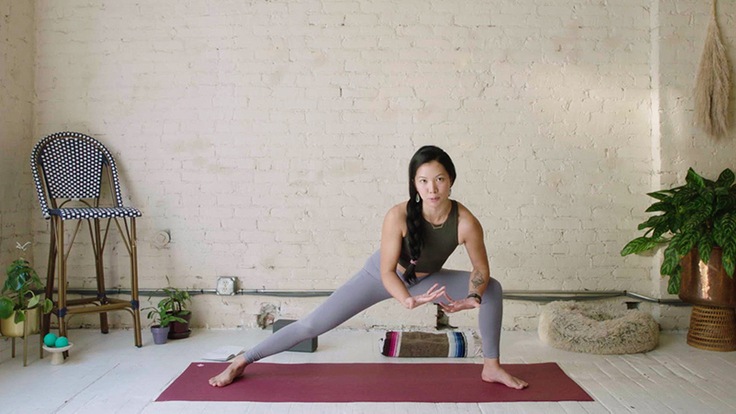Yoga is a prime way for hikers to cross-train. Both yoga and hiking help you notice the way your body moves through space, whether in a studio or a forest. And both activities challenge you to confront your physical boundaries and the goals you set for yourself. In this article, we'll discuss:
Video: Happy Feet for Hikers
In this video, yoga instructor and movement specialist Elena Cheung guides you through a 20-minute practice geared toward hikers and yoga practitioners of all levels, with a focus on your feet. Hungry for more? Try the yoga poses below, or check out other videos in the series Deeply Moving with Elena Cheung.
Benefits of Yoga for Hikers
Yoga involves physical conditioning through the asanas, or physical postures. It also invites you to become more mindful and in tune with your body. These aspects of yoga, known as Yoga of Eight Limbs, are outlined in the Yoga Sutras of Patanjali. To learn more about the eight limbs, read Yoga for Everyone - How to Get Started. The other seven limbs include pranayama (breath mastery), dhyana (meditation) and others, all of which benefit hikers. Read on to learn more, or jump ahead:
- Physical Poses (Asanas)
- Breath Mastery (Pranayama)
- Withdrawal of the Senses (Pratyahara)
- Concentration (Dharana) and Meditation (Dhyana)
Physical Postures (Asanas)
Yoga can help you build strength for challenging hikes. Yoga postures requiring balance can help you train to navigate stream crossings and rocky, rooty trails. And yoga can help you recover, so you're ready for the next adventure. Read on to learn about yoga's physical benefits.
Yoga helps improve mobility. Yoga stretches the muscles, ligaments and tendons that support the joints you use while hiking, like your shoulders, hips, knees and ankles.
Yoga helps build strength. A consistent yoga practice can strengthen and stabilize your whole body, including big muscles, like your glutes and calves, which start firing as soon as you head uphill, as well as small muscles, like your iliopsoas, which helps you lift your leg and place it on the path in front of you.
Yoga helps with balance and proprioception. Ever wobble on a rock while hopping your way across a stream on a hike? Yoga teaches you balancing postures that can help you navigate rough terrain while hiking. Proprioception is your body's ability to sense its position as you move through space. You mainly walk in a single plane of motion when hiking. But yoga requires you to move in multiple planes; practice long enough and you'll be better equipped for challenges like traversing a scree field and keeping steady while wearing a hefty pack.
Yoga helps hikers recover. A gentle yoga class can help you recuperate, so you're ready for the next big hike or backpacking trip. Practice yoga after a hike or on a rest day to keep your joints limber and send blood and oxygen to your muscles.
Breath Mastery (Pranayama)
It's human nature to hold your breath during an intense effort. But yoga teaches you to breathe smoothly in and out through your nose, which research demonstrates can calm the nervous system. Tuning into your breath can help you stay calm and be more aware of your body when you're hiking.
Try this breathing exercise the next time you're out on a hike: Exhale all the way out through your mouth. Then practice breathing in time with your gait. Start by inhaling through your nose for two steps, then exhaling through your mouth for three steps. Repeat this several times, then return to your normal breath pattern and see if you notice the difference. Stick with this practice and you may find that you're better able to keep calm during challenging moments, both on and off the trail.
Withdrawal of the Senses (Pratyahara)
Pratyahara, the yogic practice of drawing inward, can be helpful for hikers venturing outside. Imagine this: It's a spring day and you've spent all winter dreaming about reaching the summit of your next hike. You decide to load up the car and drive to the trailhead. But, 30 minutes into the adventure, the wind picks up and thunder rumbles in the distance. You head back to the car, but not without hemming and hawing a bit.
When you're hiking, it's important to keep an eye on the weather, your gear, the level of experience of your hiking buddies, and more. But it's also helpful to be in touch with your own intentions. Practicing pratyahara—both on and off the yoga mat—can make you more self-aware about having to abandon that summit effort prematurely; it might even soften the disappointment you feel in the moment.
Concentration (Dharana) and Meditation (Dhyana)
Concentration (dharana) is the precursor to meditation (dhyana). Here's how to give it a try: Find a comfortable seat and choose a single point of focus for five to 10 minutes. You might concentrate on a physical object (like a bowl of fruit on the table), a mental image (like a snowy mountain peak) or your breath moving in and out. This practice will help quiet your mind. When your mind is quiet, it's less reactive.
This can be a useful tool when you're hiking. Adopting a single point of focus (like the sound of leaves crunching underfoot) can help you slow down your thoughts. When your pack feels heavy or your legs are tired, you might pause and reflect, "This is really tough!" before pulling to the side of the trail to take a breather.
Key Yoga Poses for Hikers
Half Sun Salutation (Ardha Surya Namaskar)
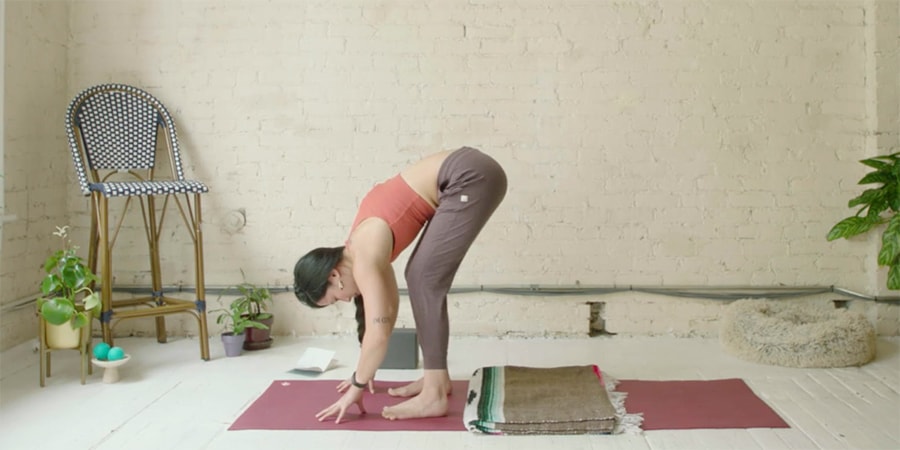
Benefits: This series of poses can get your blood pumping before a hike, or help you wind down after a challenging effort.
How to do it: Stand tall at the front of your mat. Inhale and reach your arms overhead. Next, exhale and fold forward, keeping your knees softly bent. Inhale and lift up halfway, placing your palms on your thighs in a flat back position. Next, exhale and fold forward, releasing tension and letting your head hang. Finally, inhale and sweep your arms skyward as you return to a standing pose. Repeat the series three or four times.
Downward-Facing Dog (Adho Mukha Shvanasana)
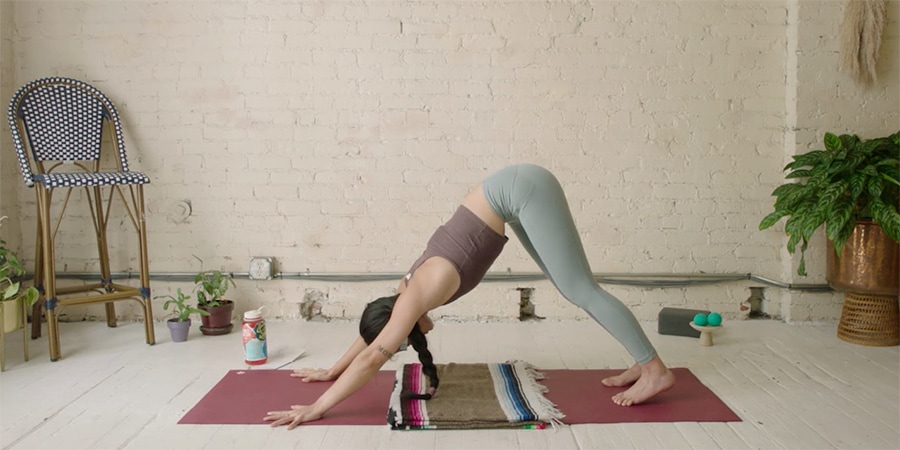
Benefit: Downward-facing dog relieves tension along the backside of your body; many hikers feel a release in their shoulders, spine, hamstrings and calves.
How to do it: Start on your hands and knees in a tabletop pose. Inhale and press your hips up and back toward the wall behind you. Straighten your arms without locking your elbows. To begin, keep a bend in your knees and think about tilting your tailbone toward the sky. Eventually, straighten your knees and press your heels down toward the floor. Take 10 slow breaths.
Low Lunge with Side Bend (Parsva Anjaneyasana)
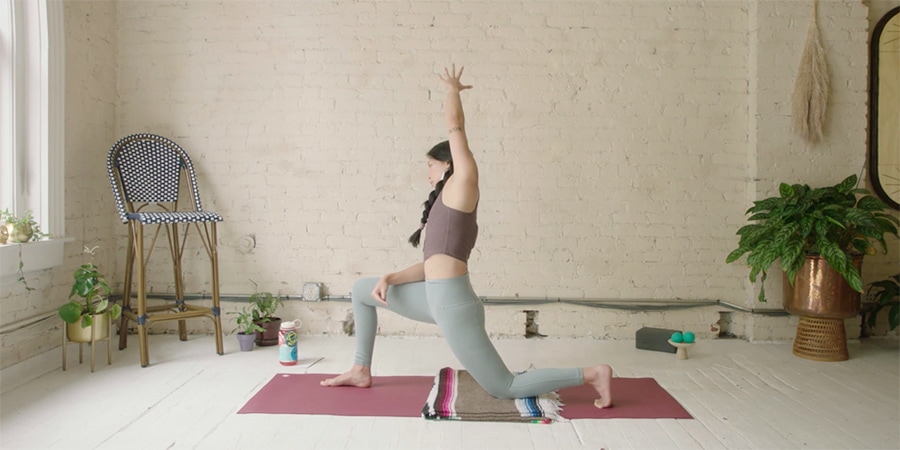
Benefit: A low lunge where your back knee rests on the floor behind allows you to mobilize and stretch your hips and legs. Many hikers feel a release in the front of their hips. Adding a side bend stretches your side body and can help relieve lower-back discomfort.
How to do it: Find a low lunge with your right knee stacked over your right ankle and your left leg extended on the floor behind you. (For more of a challenge, lift your back knee off the floor.) Take your arms overhead and breathe. From there, bring your right hand to your right thigh and stretch your left arm overhead and then over to the right. Think about reaching toward the opposite corner of the room. Hold the pose for five to eight breaths. Then, switch and repeat with the left leg forward and your right leg behind you.
Deep Squat (Malasana)
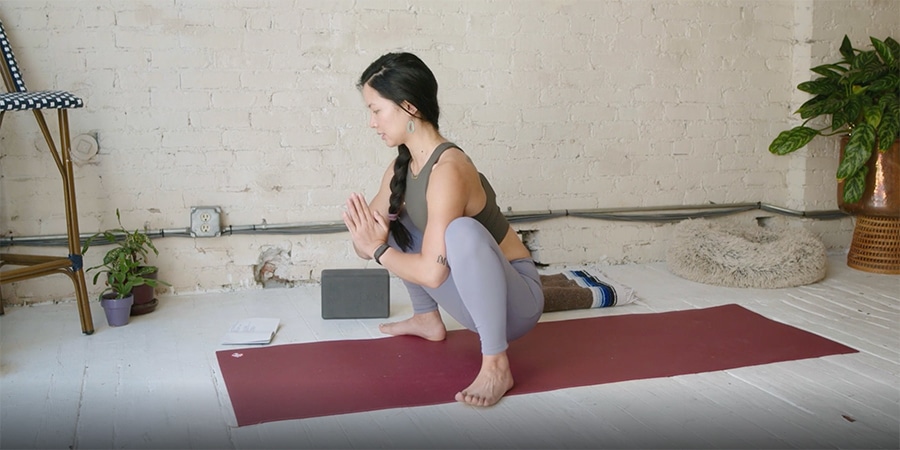
Benefit: A deep squat like malasana can release tension in your inner thighs, glutes and ankles.
How to do it: Take a deep squat, allowing your butt to descend toward the floor between your ankles. Rest your hands on the floor, on your thighs or in front of your heart, and try to maintain contact with the floor with your heels. If you're having trouble, place your butt on a yoga block or blanket to help you maintain proper form. Hold the pose for 10 breaths.
How to Fit Yoga Into Your Hiking Routine
Find a yoga class: Seek out classes labeled "gentle," "beginner" or "yoga for athletes" when you're starting out. Pay attention to the classes and instructors you enjoy, then prioritize those styles moving forward. An ideal class will focus on the muscles, ligaments and tendons in your lower body. But it's a good idea to seek out a practice that works your whole body, too, since it's your upper and lower body working together that helps propel you down the trail.
Other helpful tips to get started:
- Practice yoga after you hike or on a rest day.
- Consider where you are in your hiking season: A more active or vigorous yoga practice is a great way to cross-train during colder months, or when the trails are less accessible.
- Listen to your body when beginning or deepening a physical routine like yoga. If you're feeling wiped out, or if a pose is painful, be sure to take time to rest.
- Try more vigorous "vinyasa," "flow" or "power yoga" classes once you have a consistent yoga practice under your belt. Prioritize more active classes on days when you aren't already pushing your body to the limit.
Related articles
Remember: Safety is your responsibility. No online article or video can replace proper instruction and experience—this article is intended solely as supplemental information. Be sure you're practiced in proper techniques and safety requirements before you engage in any outdoor activity.
Article by Jess Bernhard. A former editor for REI's Uncommon Path and Expert Advice, Jess is a Seattle-based writer specializing in storytelling about women and the outdoors. When she's not writing, you can find her reading, running or chasing after her toddler daughter. REI Co-op Member since 2009.
